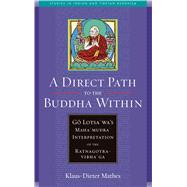
Note: Supplemental materials are not guaranteed with Rental or Used book purchases.
Purchase Benefits
What is included with this book?
| Abbreviations | p. viii |
| Preface | p. ix |
| Introduction | p. 1 |
| General Remarks | p. 1 |
| Delimitation of the Subject and Methods Employed | p. 3 |
| The Ratnagotravibhaga and Its Vyakhya | p. 7 |
| The Reaction of Mainstream Mahayana to the Theory of Buddha Nature | p. 17 |
| The Tibetan Historical Context | |
| The Development of Various Traditions of Interpreting Buddha Nature | p. 25 |
| Ngog Loden Sherab's Analytical Interpretation of the Ratnagotravibhaga | p. 25 |
| Ratnagotravibhaga Commentaries in the Meditation Tradition | p. 32 |
| The Mahamudra Interpretation of the Ratnagotravibhaga | p. 34 |
| The Zhentong Interpretation of the Ratnagotravibhaga | p. 45 |
| Various Positions Related to Zhonu Pal's Interpretation | p. 49 |
| The Position of the Third Karmapa Rangjung Dorje | p. 51 |
| The Position of Dolpopa Sherab Gyaltsen | p. 75 |
| The Position of Sabzang Mati Panchen | p. 84 |
| The Position of Lodro Tsungme | p. 91 |
| The Position of Longchen Rabjampa | p. 98 |
| The Position of Barawa Gyaltsen Palzang | p. 113 |
| A Comparison of the Positions | p. 125 |
| A Short Account of the Most Important Events in Zhonu Pal's Life | p. 131 |
| Translation | |
| Zhonu Pal's Ratnagotravibhagavyakhya Commentary | p. 151 |
| Translator's Introduction | p. 151 |
| Technical Notes | p. 154 |
| The Commentary on the Treatise "Mahayana-Uttaratantra": The Mirror Showing Reality Very Clearly (Introduction and Initial Commentaries) | p. 157 |
| Introduction | p. 157 |
| The Commentary for Those with Sharp Faculties | p. 169 |
| The Commentary for Those with Average Faculties | p. 180 |
| The Explanation of RGV I.1 | p. 181 |
| The Explanation of RGV I.2 | p. 204 |
| The Three Jewels: Buddha, Dharma, and Sangha | p. 205 |
| Buddha Nature and Its Purification through the Three Dharmackras | p. 214 |
| Enlightenment, Buddha Qualities, and Activity | p. 309 |
| A Short Explanation of RGV I.3 | p. 312 |
| Zhonu Pal's Views on Buddha Qualities, Emptiness, and Mahamudra | |
| Buddha Qualities | p. 317 |
| General Remarks | p. 317 |
| Different Views on Buddha Qualities | p. 318 |
| The Blossoming of Subtle Qualities | p. 320 |
| The Examples Used to Illustrate the Growth of the Qualities | p. 342 |
| The Ontological Status of the Buddha Qualities | p. 344 |
| Two Types of Emptiness | p. 351 |
| Zhonu Pal's Mahamudra Interpretation of the Ratnagotravibhaga | p. 367 |
| The Ratnagotravibhaga as a Basis for Mahamudra Instructions | p. 367 |
| The Three Dharmacakras: Mahamudra Hermeneutics | p. 368 |
| The Mahamudra Approach of Yogic Direct Valid Cognitions | p. 373 |
| Sutra-Based Mahamudra Meditation | p. 377 |
| The First Mahamudra Yoga of One-Pointedness | p. 381 |
| The Second Mahamudra Yoga of Freedom from Mental Fabrications | p. 382 |
| The Third Mahamudra Yoga of One Taste | p. 384 |
| The Fourth Mahamudra Yoga of Nonmeditation | p. 385 |
| The Four Mahamudra Yogas and the Ratnagotravibhaga | p. 386 |
| Zhonu Pal's Justification of a Sudden Mahamudra Path | p. 397 |
| Pairs of Paradoxes | p. 406 |
| Conclusion | p. 411 |
| Notes | p. 423 |
| Table of Tibetan Transliteration | p. 555 |
| Bibliography | p. 565 |
| Subject Index | p. 589 |
| Indian Text Index | p. 607 |
| Table of Contents provided by Ingram. All Rights Reserved. |
The New copy of this book will include any supplemental materials advertised. Please check the title of the book to determine if it should include any access cards, study guides, lab manuals, CDs, etc.
The Used, Rental and eBook copies of this book are not guaranteed to include any supplemental materials. Typically, only the book itself is included. This is true even if the title states it includes any access cards, study guides, lab manuals, CDs, etc.